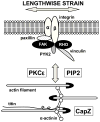Mechanical stress-induced sarcomere assembly for cardiac muscle growth in length and width
- PMID: 20188736
- PMCID: PMC2854192
- DOI: 10.1016/j.yjmcc.2010.02.016
Mechanical stress-induced sarcomere assembly for cardiac muscle growth in length and width
Abstract
A ventricular myocyte experiences changes in length and load during every beat of the heart and has the ability to remodel cell shape to maintain cardiac performance. Specifically, myocytes elongate in response to increased diastolic strain by adding sarcomeres in series, and they thicken in response to continued systolic stress by adding filaments in parallel. Myocytes do this while still keeping the resting sarcomere length close to its optimal value at the peak of the length-tension curve. This review focuses on the little understood mechanisms by which direction of growth is matched in a physiologically appropriate direction. We propose that the direction of strain is detected by differential phosphorylation of proteins in the costamere, which then transmit signaling to the Z-disc for parallel or series addition of thin filaments regulated via the actin capping processes. In this review, we link mechanotransduction to the molecular mechanisms for regulation of myocyte length and width.
Copyright (c) 2010 Elsevier Ltd. All rights reserved.
Figures



Similar articles
-
CapZ integrates several signaling pathways in response to mechanical stiffness.J Gen Physiol. 2019 May 6;151(5):660-669. doi: 10.1085/jgp.201812199. Epub 2019 Feb 26. J Gen Physiol. 2019. PMID: 30808692 Free PMC article.
-
Molecule specific effects of PKA-mediated phosphorylation on rat isolated heart and cardiac myofibrillar function.Arch Biochem Biophys. 2016 Jul 1;601:22-31. doi: 10.1016/j.abb.2016.01.019. Epub 2016 Feb 15. Arch Biochem Biophys. 2016. PMID: 26854722 Free PMC article.
-
Osmotic compression of single cardiac myocytes eliminates the reduction in Ca2+ sensitivity of tension at short sarcomere length.Circ Res. 1995 Jul;77(1):199-205. doi: 10.1161/01.res.77.1.199. Circ Res. 1995. PMID: 7788878
-
Under construction: The dynamic assembly, maintenance, and degradation of the cardiac sarcomere.J Mol Cell Cardiol. 2020 Nov;148:89-102. doi: 10.1016/j.yjmcc.2020.08.018. Epub 2020 Sep 10. J Mol Cell Cardiol. 2020. PMID: 32920010 Free PMC article. Review.
-
The vertebrate muscle Z-disc: sarcomere anchor for structure and signalling.J Muscle Res Cell Motil. 2009;30(5-6):171-85. doi: 10.1007/s10974-009-9189-6. Epub 2009 Oct 15. J Muscle Res Cell Motil. 2009. PMID: 19830582 Free PMC article. Review.
Cited by
-
Cardiomyocyte subdomain contractility arising from microenvironmental stiffness and topography.Biomech Model Mechanobiol. 2015 Jun;14(3):589-602. doi: 10.1007/s10237-014-0624-2. Epub 2014 Oct 2. Biomech Model Mechanobiol. 2015. PMID: 25273278 Free PMC article.
-
Heart Plasticity in Response to Pressure- and Volume-Overload: A Review of Findings in Compensated and Decompensated Phenotypes.Front Physiol. 2020 Feb 13;11:92. doi: 10.3389/fphys.2020.00092. eCollection 2020. Front Physiol. 2020. PMID: 32116796 Free PMC article. Review.
-
Renal-Cardiac Crosstalk in the Pathogenesis and Progression of Heart Failure.Circ Res. 2025 May 23;136(11):1306-1334. doi: 10.1161/CIRCRESAHA.124.325488. Epub 2025 May 22. Circ Res. 2025. PMID: 40403103 Free PMC article. Review.
-
Multiscale Models of Cardiac Muscle Biophysics and Tissue Remodeling in Hypertrophic Cardiomyopathies.Curr Opin Biomed Eng. 2019 Sep;11:35-44. doi: 10.1016/j.cobme.2019.09.005. Epub 2019 Sep 18. Curr Opin Biomed Eng. 2019. PMID: 31886450 Free PMC article.
-
Induction of cardiac fibulin-4 protects against pressure overload-induced cardiac hypertrophy and heart failure.Commun Biol. 2025 Apr 24;8(1):661. doi: 10.1038/s42003-025-08087-8. Commun Biol. 2025. PMID: 40274989 Free PMC article.
References
-
- Esposito G, Rapacciuolo A, Naga Prasad SV, Takaoka H, Thomas SA, Koch WJ, et al. Genetic alterations that inhibit in vivo pressure-overload hypertrophy prevent cardiac dysfunction despite increased wall stress. Circulation. 2002;105:85–92. - PubMed
-
- Russell B, Motlagh D, Ashley WW. Form follows function: how muscle shape is regulated by work. J Appl Physiol. 2000;88:1127–1132. - PubMed
-
- Gerdes AM, Kellerman SE, Moore JA, Muffly KE, Clark LC, Reaves PY, et al. Structural remodeling of cardiac myocytes in patients with ischemic cardiomyopathy. Circulation. 1992;86:426–430. - PubMed
-
- Gregorio CC, Antin PB. To the heart of myofibril assembly. Trends Cell Biol. 2000;10:355–362. - PubMed
Publication types
MeSH terms
Substances
Grants and funding
LinkOut - more resources
Full Text Sources

